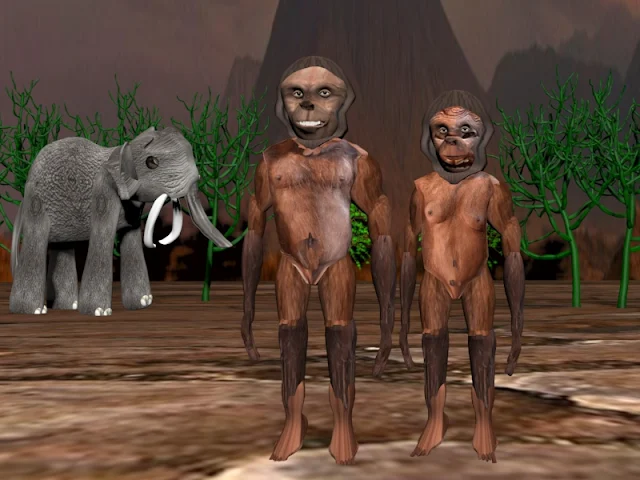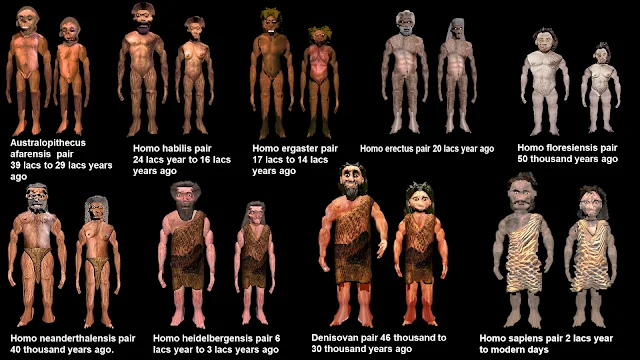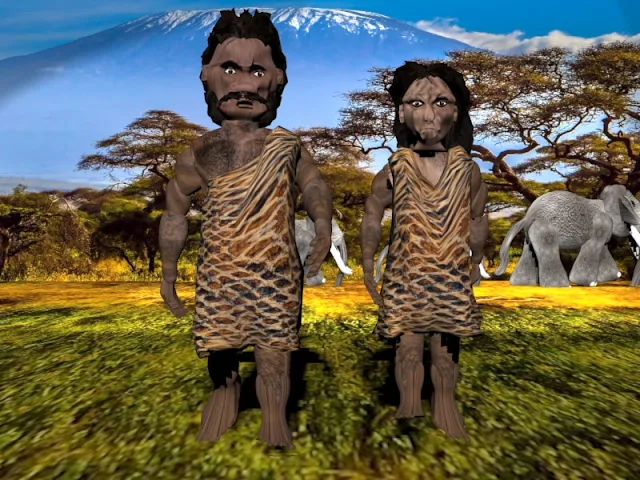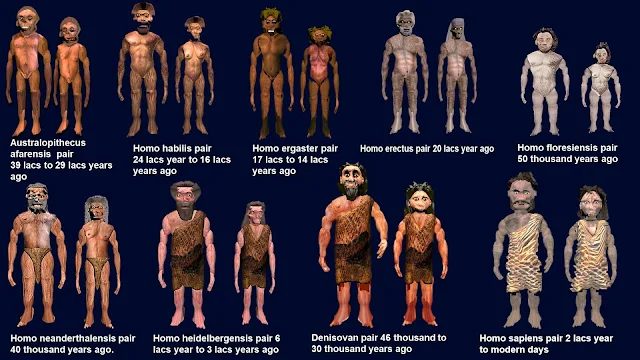Summery and comparative study of different human species of Human Evolution:
Let's embark
on a journey tracing our evolutionary steps—from our early bipedal ancestors in
the form of Australopithecus to the enigmatic archaic hominins known as
Denisovans. This narrative isn’t a simple, straight-line progression but a
sprawling, branching network of species, each contributing unique traits and
adaptations that have culminated in the modern human being .
Australopithecus:
The Pioneers of Bipedalism
Australopithecines
roamed Africa roughly between 4 and 2 million years ago. Although small-brained
compared to later hominins, these early ancestors showcased remarkable
adaptations. Their skeletal structure reveals a mix of ape-like features and
early signs of bipedalism—a crucial adaptation that not only set the stage for
the efficient use of energy but also paved the way for the tool use and complex
behaviors that would come later. Iconic specimens like Australopithecus
afarensis (famously represented by “Lucy”) provide compelling evidence of how
our ancestors began experimenting with upright walking, thereby freeing their
hands for other tasks .
 |
| Australopithecus afarensis pair |
The Rise
of the Genus Homo
The
transition from Australopithecus to the genus Homo marks a pivotal shift in our
lineage. Around 2.4 million years ago, Homo habilis emerged in Africa. Known as
the “handy man,” this species is credited with some of the earliest forms of
stone tool production, suggesting an evolution in cognitive abilities and
manual dexterity. With a modest increase in brain size compared to their
australopithecine predecessors, these early toolmakers laid the groundwork for
further innovation .
 |
| Homo habilis pair |
 |
| Homo habilis pair with their Stone Tools |
Shortly
after, Homo erectus evolved and became one of the most widespread and enduring
hominins. Existing from roughly 1.9 million years ago until as late as 143,000
years ago in some regions, H. erectus was marked by a significant leap in brain
capacity and a more refined tool-making ability. Notably, these hominins were
also the first to harness the use of fire and to venture out of Africa,
colonizing vast swathes of Eurasia. Their dispersal set the stage for future
speciation events as groups adapted to diverse and challenging environments 2.
 |
| Homo erectus pair |
Transitional
Forms: Homo heidelbergensis as a Common AncestorBetween Homo erectus and later archaic
humans lies another key player: Homo heidelbergensis. Living approximately
700,000 to 300,000 years ago, this species is often regarded as the common
ancestor to both Neanderthals in Europe and Western Asia, as well as the
Denisovans in Asia. H. heidelbergensis showcased a blend of advanced tool use,
larger brain size, and social complexity, characteristics that further refined
the physical and cultural attributes of later hominins. The species' widespread
distribution across Africa, Europe, and parts of Asia underscores its
evolutionary success and its critical role as a branching point in the human
family tree 2.
 |
| Homo heidelbergensis pair |
Divergence
into Neanderthals and Denisovans
Following
the divergence from a common ancestor, two distinct groups emerged out of H.
heidelbergensis: the Neanderthals and Denisovans.
 |
| Neanderthals (Homo neanderthalensis) pair |
Neanderthals
(Homo neanderthalensis) evolved in Europe and western Asia. Adapted to colder
climates, they developed robust physiques, intricate tool cultures, and even
ritualistic behaviors. Their fossils and cultural artifacts reveal a species
that was highly adapted to its environment, with anatomical features suited for
life in glacial contexts .
 |
| Denisovans pair |
Denisovans,
on the other hand, are known primarily from genetic evidence and fragmentary
fossils discovered at Denisova Cave in the Altai Mountains of Siberia.
Initially identified in 2010 through advanced DNA analysis, Denisovans have
been shown to be a distinct branch of archaic humans, genetically closer in
some respects to Neanderthals than to modern humans. Although their physical
appearance remains largely a mystery—with a few skeletal fragments hinting at
robust features—their genetic legacy is evident in modern human populations in
Asia and Oceania, where remnants of Denisovan DNA contribute to adaptations in
immunity and possibly other physiological traits 2.
A Glimpse
into Our Genetic Mosaic
It’s crucial
to acknowledge that human evolution isn’t a clean succession of species
replacing one another. Instead, it’s marked by bouts of divergence and
subsequent interbreeding among various groups. Modern non-African human
populations carry about 1–2% Neanderthal DNA, while certain populations in Asia
and Oceania have inherited an additional 4–6% of Denisovan genetic material.
This genetic mosaic provides us with clues about ancient interactions and
adaptations that helped our ancestors thrive in varied environments—from harsh
ice age Europe to the diverse climates of Asia

Beyond
the Timeline:
While each
of these groups carved out their own niche in the vast expanse of evolutionary
time, the story of human evolution reminds us that our past is
interwoven with genetic, cultural, and technological adaptations. Fossil discoveries and genetic advancements continue to refine our understanding of these ancient branches. For instance, the discovery of Denisovan DNA has revolutionized our view of hominin diversity and emphasized the importance of genetic studies in untangling the complex web of our ancestry.
Furthermore, exploring aspects such as how climatic shifts influenced migration, how tool-making technology evolved concurrently with our cognitive abilities, and the archaeological techniques used to uncover these secrets can provide deeper insights. Engaging with these ideas not only enriches our understanding of where we come from—it also inspires us to consider how our unique blend of genetic heritage informs modern human diversity and resilience.
Would you
like to explore more about the specific adaptations of these hominins, dive
deeper into the genetic evidence that underpins these discoveries, or perhaps
discuss how these evolutionary milestones have been represented in art and
culture throughout history?
Homo
ergaster
Homo
ergaster lived in eastern Africa roughly between 1.8 and 1.3 million years ago.
Often considered either a distinct species or an early African variant of Homo
erectus, ergaster embodies a pivotal shift from the more primitive traits seen
in earlier hominins to the anatomy and behaviors that more closely resemble
later human forms. Key evolutionary features include:
 |
| Homo ergaster pair |
Enhanced
Bipedalism and Body Adaptation:
Ergaster’s skeletal structure—marked by a slender body and long lower
limbs—suggests a body built for efficient long-distance travel, an adaptation
that would have been critical for survival on open savanna landscapes.
Cranial
and Facial Changes:
Compared to its predecessors, ergaster exhibits a larger braincase, less
pronounced brow ridges, and a flatter face. These changes hint at emerging
cognitive and social complexities.
Tool Use
and Dispersal:
Ergaster’s anatomy coincides with advances in stone tool technology (part of
the Acheulean tradition) and may represent one of the first hominins to venture
beyond Africa. This spread is a cornerstone in tracing the lineage that
eventually leads to later species, including modern humans.
In essence,
Homo ergaster represents a crucial stepping stone—highlighting adaptive
innovations and a capacity for exploration that set the stage for the diverse
array of human species that followed.
Homo
floresiensis
Assuming you
mean Homo floresiensis (since “flurensis” is sometimes a typographical mix-up),
this species was discovered on the Indonesian island of Flores and dates as
recently as about 50,000 years ago. Its significance is profound for several
reasons:'
 |
| Homo floresiensis pair |
A Case of
Evolutionary Experimentation:
With its notably small stature and cranial volume—far below what we typically
associate with hominins—H. floresiensis challenges the assumption that larger
brain size directly correlates with advanced tool use or sophisticated
behavior. The stone tools associated with this species suggest that cognitive
abilities can manifest in varied ways.
Insular
Dwarfism: Its
existence on an isolated island offers a prime example of how environmental
pressures can lead to dramatic evolutionary adaptations, such as reduced body
size, a phenomenon seen in other animal species on islands.
Broadening
the Human Evolution Narrative:
Rather than a neat, linear progression, the presence of H. floresiensis
highlights a branching evolutionary tree. It serves as a reminder that multiple
hominin species—with distinct body plans, ecological strategies, and even
cultural practices—existed concurrently. This diversity compels us to reassess
how we define “modern” traits and to appreciate the mosaic nature of evolution.
































 Online Movies
Online Movies
No comments:
Post a Comment